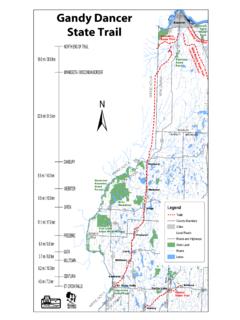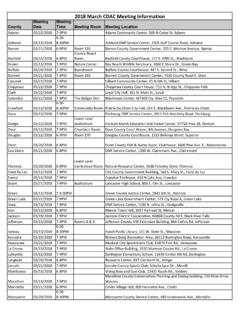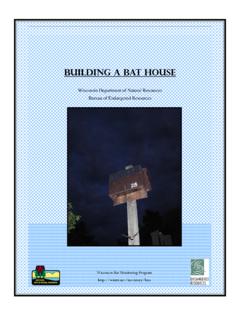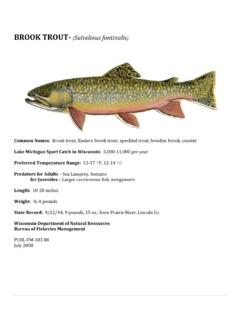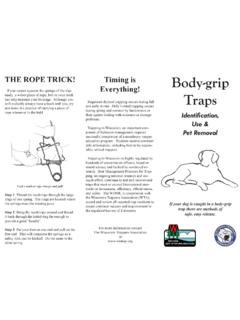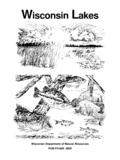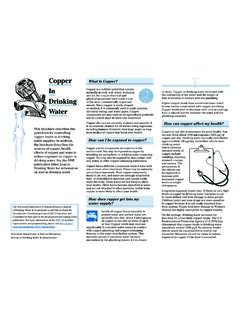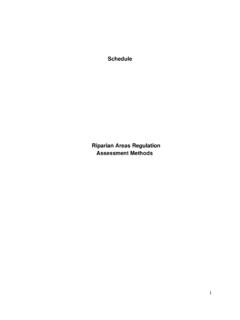Transcription of Basic Disinfection Study Guide - Wisconsin DNR
1 Printed on 02/03/16 Basic Disinfection Study GuideFebruary 2016 Wisconsin Department of Natural ResourcesBureau of Science Services, Operator Certification ProgramPO Box 7921, Madison, WI 53707 DWisconsin Department of Natural ResourcesThe Wisconsin Department of Natural Resources provides equal opportunity in its employment, programs, services, and functions under an Affirmative Action Plan. If you have any questions, please write to Equal Opportunity Office, Department of Interior, Washington, 20240. This pub lication is availab le in alternative format (large print, Braille, audio tape. etc.) upon request. Please call (608) 266-0531 for more Operator CertificationPrinted on 02/03/16 PrefaceThe Disinfection Study Guide is an important resource for preparing for the certification exam and is arranged by chapters and sections. Each section consists of key knowledges with important informational concepts you need to know for the certification exam.
2 This Study Guide also serves as a wastewater treatment plant operations primer that can be used as a reference on the on February 2016 edition: Key knowledges and were slightly preparing for the exams:1. Study the material! Read every key knowledge until the concept is fully understood and known to Learn with others! Take classes in this type of wastewater operations to improve your understanding and knowledge of the Learn even more! For an even greater understanding and knowledge of the subjects, read and review the references listed at the end of the Study of the Study Guide material will be tested using a multiple choice format. Every test question and answer comes directly from one of the key a test date:Before choosing a test date, consider the time you have to thoroughly Study the guides and the training opportunities available. A listing of wastewater training opportunities and exam dates is available at by searching for the keywords Operator Certification.
3 AcknowledgementsThe Disinfection Study Guide was the result of a collaborative effort of yearlong monthly meetings of wastewater operators, trainers, consultants, the Wisconsin Wastewater Operator Association (WWOA), and the Wisconsin Department of Natural Resources (WDNR). This Study Guide was developed as the result of the knowledge and collective work of following workgroup members: Dan Tomaro, Wastewater Training Solutions, Oregon, WIRich Knoelke, Mulcahy/Shaw Water, Inc., Cedarburg, WIKay Curtin, Short Elliot Hendricksen, Delafield, WIThomas Kruzick, Oshkosh WWTP, Oshkosh, WIRobert Kennedy, DePere WWTP, DePere, WITodd Fischer, Richland Center WWTP, Richland Center, WIDavid Sasada, Hawkins Chemical, Inc., Fond du Lac, WIGary Hanson, AECOM, Sheboygan, WIJennifer Wuest, Department of Natural Resources, Madison, WIHannah Fass, Department of Natural Resources, Madison, WIDanielle Luke, Department of Natural Resources, Madison, WIJack Saltes, Department of Natural Resources, Madison, WIBasic Disinfection Study Guide - Sub class DPrinted on 02/03/16 Part 1 - ChlorinationPart 2 - UltravioletChapter 1 - Theory and PrinciplesChapter 2 - Operation and MaintenanceChapter 3 - Monitoring, Process Control, and TroubleshootingChapter 4 - SafetyChapter 5 - CalculationsChapter 6 - Theory and PrinciplesChapter 7 - Operation and MaintenanceChapter 8 - Monitoring, Process Control.
4 And TroubleshootingSection - DefinitionsSection - Pathogen KnowledgeSection - Chlorination and Dechlorination ChemistrySection - Process Understanding and Performance Limiting FactorsSection - DefinitionsSection - MethodsSection - EquipmentSection - Handling and StorageSection - Preventive MaintenanceSection - DefinitionsSection - Sampling and TestingSection - Data Understanding and InterpretationSection - Regulations and ProceduresSection - EquipmentSection - Chemical ConsiderationsSection - CalculationsSection - DefinitionsSection - Process Understanding and Performance Limiting FactorsSection - DefinitionsSection - EquipmentSection - Preventive MaintenanceSection - Sampling and TestingSection - Data Understanding and InterpretationTable of ContentsBasic Disinfection Study Guide - Subclass Dpg. 1pg. 2pg. 2pg. 5pg. 6pg. 6pg. 8pg. 10pg. 14pg. 15pg. 15pg. 17pg. 20pg. 21pg. 23pg. 25pg.
5 30pg. 30pg. 33pg. 33pg. 35pg. 36pg. 36 Printed on 02/03/16 Chapter 9 - SafetySection - DefinitionsSection - Regulations and ProceduresSection - EquipmentTable of ContentsBasic Disinfection Study Guide - Subclass Dpg. 37pg. 37pg. 37 Printed on 02/03/16 Page 1 of 39 Part 1 - ChlorinationChapter 1 - Theory and PrinciplesSection - DefinitionsBreakpoint chlorination is the process of using chlorine s oxidative capacity to oxidize ammonia to nitrogen. At this point, free chlorine residual starts to is the addition of chlorine and/or chlorine compounds to treated wastewater in order to achieve total chlorine is the amount of chlorine that has combined with ammonia to form chloramines or other chlorine is the process of removing chlorine from treated effluent prior to discharge tosurface water. Dechlorination is used to remove potentially toxic chlorine compounds that could injure fish and other aquatic life in the receiving mean is a statistical measure of central tendency that minimizes the effect of outliers.
6 It is different from an arithmetic average and is used because of geometric growth rates of bacteria (1, 2, 4, 8, 16, 32, etc.). When calculating a geometric mean, a zero value cannot be used in the calculation and therefore all zeros should use one (1) as the organism used to determine the effectiveness of Disinfection is a bacteria called fecal coliform, commonly found in the intestinal tracts of humans and other warm-blooded available chlorine is the amount of chlorine in water in the form of hypochlorous acid (HOCl) and hypochlorite ion (OCl-).Hypochlorination is the use of liquid chlorine compounds to achieve organisms are disease-causing microorganisms. They include various bacteria, viruses, and parasites. The discharge of waterborne human wastes will contain these organisms from ailing individuals and would be expected to be present in wastewater entering a wastewater treatment breakpoint combined total dechlorination and why it is required at wastewater treatment plants that use geometric mean and why it is used to average fecal coliform fecal free available pathogenic organisms and their source in Disinfection Study Guide - Subclass DPrinted on 02/03/16 Page 2 of 39 Section - Pathogen KnowledgeSection - Chlorination and Dechlorination ChemistryTotal residual chlorine is the sum of free available chlorine and combined available chlorine.
7 Monitoring requirements for discharge permits require total residual chlorine TFO is a release of wastewater, other than through permitted outfalls, from a wastewater facility into a water of the state or the land surface. All TFOs must be reported to the Department of Natural Resources within 24 hours of their GastroenteritisB. DysenteryC. Hepatitis B and CD. GiardiasisE. Upper respiratory illnessesDisinfection of treated wastewater is practiced to reduce the discharge of waterborne pathogenic organisms. This is done to protect public health as related to surface drinking water supplies and recreational use of downstream areas. Seasonal Disinfection provides effluent Disinfection during the period when recreational activities occur and are discontinued when use of the water is limited due to climatic the Disinfection process, the destruction of the indicator organism would mean the likely destruction of pathogenic organisms.
8 The indicator bacteria, fecal coliform, is not pathogenic, but is much easier and less costly to detect than individual pathogens. If fecal coliform bacteria are adequately controlled, it can be expected that other pathogenic bacteria are proportionally inactivated. The inactivation of viruses cannot be expected at the same rate as the indicator organism because viruses are more difficult to total residual treatment facility overflow (TFO).List the prevalent diseases that can be contracted through wastewater the reasons for disinfecting treated the significance of using an indicator the physical properties of chlorine as a liquid and Disinfection Study Guide - Subclass DPrinted on 02/03/16 Page 3 of 39 Figure DosageThe dosage is the amount of chlorine fed to achieve Disinfection and is normally reported asa concentration in milligrams per liter (mg/L) or pounds per day (lbs/day).B. DemandThe demand is the amount of chlorine (mg/L) used to disinfect wastewater after a given contact ResidualResidual is the amount of chlorine (mg/L) remaining after a given contact general expression of this relationship is:Chlorine residual = chlorine dosage - chlorine demandA.
9 Sulfur dioxideThe reaction of sulfur dioxide reduces all forms of chlorine to chlorides and a residual of sulfates to form small amounts of hydrochloric and sulfuric acids. Free chlorine (HOCl): SO2 + H2O + HOCL -> 3H+ + Cl- + SO4-2 Chloramines (NH2Cl): SO2 + 2H2O + NH2Cl -> NH4+ + 2H+ + Cl- + SO4-2 The theoretical dosage for dechlorination requires mg/L of sulfur dioxide for every 1 mg/L of total chlorine residual (a ratio of :1) to be removed. In most operating situations, the feed rate will be 1:1 to ensure all chlorine is removed. The contact time (assuming the relationship between chlorine dosage, chlorine demand, and chlorine the chemical reactions, feed rates, and required contact times of common dechlorination compounds used in removing Disinfection Study Guide - Subclass DPrinted on 02/03/16 Page 4 of 39mixing) is only about 2 Sodium bisulfiteSodium bisulfite reduces free chlorine to sodium bisulfate and hydrochloric acid.
10 The chloramines are converted to sodium bisulfate, hydrochloric acid, and ammonium chloride. Free chlorine: NaHSO3 + 3H2O + Cl2 -> NaHSO4 + 2 HCl Chloramines: 3 NaHSO3 + 3H2O + NH3 + 3Cl2 -> 3 NaHSO4 + 5 HCl + NH4 ClThe theoretical dosage for dechlorination requires parts of pure sodium sulfite per 1 part chlorine or chloramines (a ratio of :1). In practice, the feed rate should be 10% in excess to ensure total chlorine removal. The reaction is almost instantaneous as with sulfur Sodium metabisulfiteSodium metabisulfite reduces free chlorine to form sodium bisulfate (NaHSO4) and hydrochloric acid (HCl). The chloramines are converted to sodium bisulfate, hydrochloric acid, and ammonium chloride (NH4Cl). Free Chlorine: Na2S2O5 + 3H2O + 2Cl2 -> NaHSO4 + 2 HCl Chloramines: Na2S2O5 + 9H2O + 2NH3 +6Cl2 -> 6 NaHSO4 + 10 HCl + 2NH4 ClThe theoretical dosage for dechlorination requires parts of pure sodium metabisulfite for 1 part of chlorine or chloramine (a ratio of :1).

